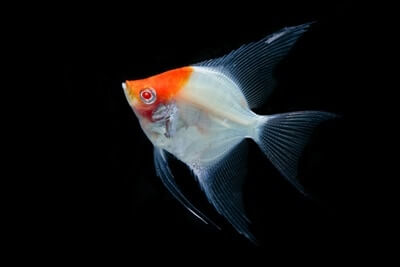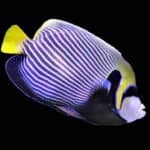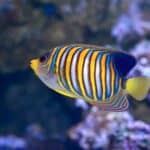Angelfish are beautiful creatures, but a body part of the body that’s sometimes overlooked is the eyes. An angelfish’s eyes are usually clear with a large black pupil.
Some species of angelfish naturally have red eyes. Similarly, albino angelfish lack dark pigments, so their eyes are pink or red like all other albino creatures.
Red or bloodshot eyes can signify a health problem, like viral hemorrhagic septicemia or injury. Angelfish poisoned by ammonia, nitrate, or CO2 may have bloody eyes.
An angelfish’s eyes sometimes change color, but not very often. If the eyes are red from birth, that’s usually the color they’ll remain.
What Does It Mean When A Fish Has Red Eyes?
Usually, red eyes are normal in angelfish. Some species, like the zebra angelfish, have naturally red eyes.
While uncommon, angelfish eyes can change color due to environmental factors, like stress or changes in the tank. Once things return to normal, the eyes should return to their original color.
Red eyes can signify a health problem if they change from clear to red.
You’ll know if a fish’s eyes are supposed to be red because they’ll develop them from a young age. If the eyes change color seemingly overnight, then something is amiss.
It’s abnormal for fish to have bloodshot or bloody eyes.
Some of the most common causes of red eyes in fish include:
Stress
As touched upon, stress can cause an angelfish’s eyes to turn red.
It can also affect the color of its scales and stripes. Eliminating the reason behind the angelfish’s stress should help the eyes return to their original color.
Signs of stress in angelfish include:
- Gasping at the surface of the tank.
- Lack of appetite or refusal to eat.
- Disease, which is often characterized by red eyes and white spots on the fish’s body.
- Frantic swimming.
- Odd swimming patterns.
Many factors can cause an angelfish to be stressed. They can be:
Poor Water Conditions
Your fish may struggle to breathe if your angelfish’s water isn’t correctly maintained.
Low oxygen levels, high levels of ammonia or nitrate, or water that is too warm or cold causes stress. Low or high pH levels are also an issue.
To find out the exact cause of the problem, you’ll need to conduct a water test. Correcting the issue should return your angelfish to their usual selves with their eyes returning to the original color.
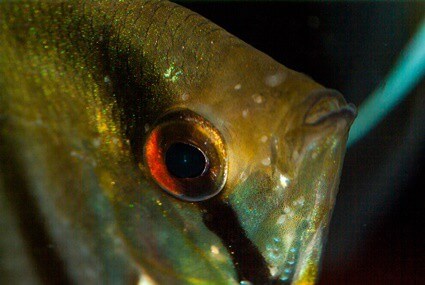
Overcrowding
Tanks too full don’t allow enough space for fish to swim in.
Angelfish are territorial creatures and will fight other fish for dominance. This is stressful for all fish involved, including those bullied into submission.
While small groups of angelfish are more likely to lead to bullying as one or two fish are singled out, 5 fish in a tank is ideal. It allows them to create a school and prevents others from being bullied.
Improper Diet
If your angelfish isn’t getting enough food, it could be stressed from hunger. Overfeeding isn’t healthy, so many fish owners accidentally underfeed instead.
When feeding your angelfish, ensure each has about 30 seconds of eating time. This indicates they’ve gotten enough food. Any more is too much, and any less isn’t enough.
If angelfish don’t eat enough, they become aggressive and fight for the available food. As a result, the peaceful fish in the tank become fearful and stressed and are most likely to develop red eyes out of all your angelfish.
Loud Noises
This is more of a problem if you have young children banging on the tank’s glass. Doing so causes extreme stress, particularly when the angelfish are trying to sleep.
Similarly, putting the tank in a room with lots of noise may cause too much disturbance and cause the angelfish’s eyes to turn red.
Chemicals In The Water
Something in your angelfish’s water could irritate its eyes, causing them to go bloodshot and red.
Toxic water leads to poisoning if not treated. It gets into the fish’s system through its gills, reaching the bloodstream quickly and causing significant damage. High levels of poison turn an angelfish’s eyes red as hemorrhaging or rupturing occurs.
The following toxins can make your fish unwell if they’re in the tank’s water:
Ammonia
Ammonia is a toxic substance to fish. New setups, harmful bacteria, or a change in the bio-load all lead to ammonia poisoning. It’s also caused by:
- Chemically-treated tap water.
- Decomposition of plants, excrement, and uneaten fish food.
- Overfeeding and lack of cleaning cause a build-up of bacteria.
Poisoned angelfish hover at the bottom of the tank and appear motionless. You might also notice internal and external bleeding alongside red eyes that appear as red patches on the body.
To stop ammonia poisoning, make sure the water’s pH is at a safe level. For angelfish, this is between 6.8 and 7.8. Ammonia found at this level is non-toxic, but anything higher can kill them.
Change 50% of the water at the same temperature as the rest of the aquarium to allow the ammonia to drop below 1 ppm.
Nitrite
Nitrite poisoning (brown blood disease) turns a fish’s blood brown due to increased methemoglobin levels. Some owners report that their fish’s eyes turned red after being poisoned by nitrite.
According to Fresenius Environmental Bulletin, nitrite is a toxicant for fish. It’s not as harmful as ammonia but still causes a range of health problems if it’s allowed to affect fish over a long period.
It most commonly occurs when the aquarium is new. Fish excrete ammonia through their gills. The ammonia is turned into nitrite by good bacteria in the tank.
While ammonia is toxic, an established tank has beneficial bacteria that feed off it and make it harmless.
In new tanks without time to cycle, ammonia can build up without enough bacteria to convert it. This leads to nitrite poisoning.
Eventually, high nitrite levels will suffocate the fish after it enters their bloodstream. Before it does, you’ll find fish gasping for air. In the most severe cases, their eyes will turn red.
For every 300 gallons of water, add 1 teaspoon of salt to see if it helps fish deal with the toxins.
CO2
CO2 poisoning is harmful and can develop quickly, so it’s deadly. Too much in the tank causes fish to gulp for air at the surface and become lethargic.
They eventually suffocate. CO2 levels above 25 to 30 ppm are dangerous.
Faulty CO2 reactors or a lack of plants in the tank to absorb it are the most likely causes. Similarly, human error leads to an excess of CO2 in the tank.
To remove excess CO2 from the water, aerate it using surface agitation and air stones.
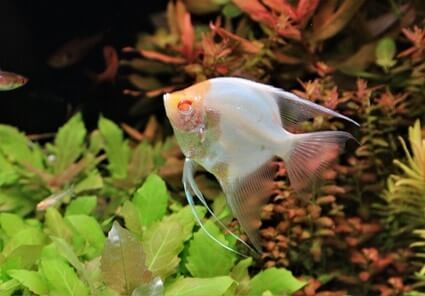
Hydrogen Sulfide
Hydrogen sulfide poisoning is rare and easily detected due to the smell of rotten eggs. Power outages and a lack of tank maintenance are both leading causes.
The symptoms of hydrogen sulfide include:
- Bloodshot eyes.
- Reduced appetite.
- Sideways swimming.
- Gulping at the surface of the tank.
Prevention is essential to save angelfish poisoned by hydrogen sulfide. Clean the gravel and everything inside it thoroughly. Rinse out the filter and restart it to be safe.
Afterward, closely measure and monitor the water quality to ensure the problem has been eradicated.
Injury
Injuries are one of the most common causes of red eyes in angelfish. Manhandling is common, especially when purchasing from unreputable breeders who don’t take much care when touching the fish.
Similarly, angelfish people who fight sometimes attack each other’s eyes. In severe injuries, blood accumulates in the eye, causing red specks or bloodshot eyes where the blood vessels have ruptured.
It’s tough to treat fish eye injuries. They usually clear up by themselves, but adding 1 to 3 teaspoons of Epsom salts per gallon of water helps to ease the swelling.
If they don’t, an infection may have taken hold and need veterinary treatment. Keep an eye on the eye to monitor whether the redness disappears – this is a sign it’s healing.
Viral Hemorrhagic Septicaemia
Viral hemorrhagic septicemia (VHS) is a severe condition that’s highly infectious and often fatal. It affects a variety of fish species, including angelfish.
According to The Center for Food Security and Public Health, fish infected with viral hemorrhagic septicemia may have hemorrhages on the eyes, body, gills, and around the fins.
Popeye might develop simultaneously. This condition is where a fish’s eyes bulge out of their socket.
As well as bloodshot eyes, the symptoms of VHS include:
- Swollen abdomen.
- Dark coloration of the body.
- Abnormal swimming behavior.
- Hemorrhaging of the muscle and organ tissues.
Some angelfish won’t show any signs of illness at all. However, they can spread the disease and infect other fish. If all fish in the tank catch the disease, they’ll likely die.
Outbreaks of viral hemorrhagic septicemia occur mainly in the spring. Water temperatures in this season drop below 59°F. VHS deaths don’t commonly happen when the water’s temperature is above 64°F.
If VHS causes your angelfish’s red eyes, quarantine it from the rest of your fish before it infects them. Drain the tank and give it, and everything inside it, a thorough clean to remove traces of the infection.
Do Albino Angelfish Have Red Eyes?
Albino angelfish are a strain of fish with golden pink body color and characteristic red eyes due to the lack of melanin pigments.
The eyes are a signature part of their appearance, and they sometimes appear light pink.
The reason why albino angelfish have red eyes is that the pigments usually conceal the blood vessels that appear underneath the eye’s iris and retina.
Albino angelfish are created when two fish with the albino genes mate. Albinos tend to have poor vision from birth and need good lighting to see where they’re swimming. However, too much might bother them, as their eyes are light-sensitive.
Without melanin pigments, the eyes can’t regulate how much light enters as it opens and closes, making the angelfish photosensitive.
The best way to determine whether there are changes is to note the angelfish’s eye color. Most will start clear. If you can’t see when their eyes have turned red, you may not notice that they have an injury or illness.
Fish can’t tell us when they’re unwell, so changes like the eye color turning red are a warning sign.

